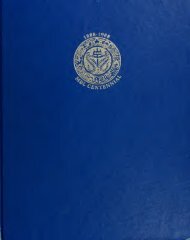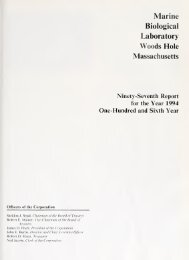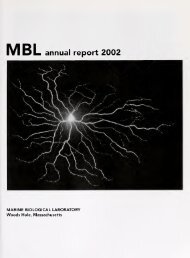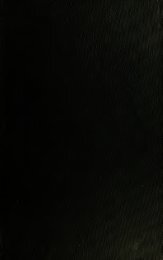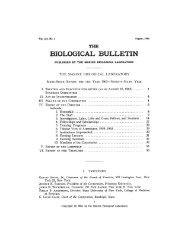42 researchMarine Resources Programs Staff, cont.LABORATORY OF ROGER HANLONSTAFFRoger Hanlon, Senior ScientistAlexandra Barbosa, Ph.D. Student, Universidade do PortoKendra Buresch, Research Assistant IIIJustin Grubich, Postdoctoral InvestigatorDawn LoBaugh, Masters StudentLydia Mathger, Research AssociateVISITING INVESTIGATORSPhilip Alatalo, Research Consultant, Woods HoleOceanographic InstitutionCharlie Chubb, <strong>University</strong> of California, IrvineChuan-Chin Chiao, National Tsing Hua <strong>University</strong>, TaiwanJohn W. Forsythe, <strong>University</strong> of Texas Medical BranchPhilip McFadden, Oregon <strong>State</strong> <strong>University</strong>Dan-Eric Nilsson, Lund <strong>University</strong>Hanu Singh, Woods Hole Oceanographic InstitutionKenneth G. Foote, Woods Hole Oceanographic InstitutionDaniel E. Morse, <strong>University</strong> of California, Santa BarbaraINTERNSHidehiko Hashimoto, Tokyo <strong>University</strong> of Marine Scienceand TechnologySarrah Kaye, Oxford <strong>University</strong>Karena Lloyd-Knight, East Stroudsburg <strong>University</strong>Annie Shea, Tufts <strong>University</strong>Simon Minor, Cape Cod Community CollegeLABORATORY OF ALAN KUZIRIANSTAFFAlan Kuzirian, Associate ScientistHerman Epstein, Investigator, Emeritus, Brandeis<strong>University</strong>VISITING INVESTIGATORSDaniel L. Alkon, Director, Blanchette RockefellerNeurosciences Institute, John Hopkins <strong>University</strong>Ryo Kawai, Post-doctoral Fellow, BlanchetteRockefeller Neurosciences Institute, John Hopkins<strong>University</strong>Manabu Sakakibara, Professor, Laboratory ofNeurobiology & Engineering, Tokai <strong>University</strong>,Shizuoka, JapanTakeshi Karasawa, Graduate Student, Laboratoryof Neurobiology & Engineering, Tokai <strong>University</strong>,Shizuoka, JapanINTERNSJosiah Coffey, Cape Cod Community CollegeChristopher Gagliardi, Rogers Williams <strong>University</strong>Christie (Taylor) Parrish, <strong>University</strong> of MichiganCollaboration with Becky Gast of the Woods Hole OceanographicInstitution includes using nested PCR detection; we areconducting environmental studies of sediment, water column,and marine snow samples to identify reservoirs of Quahog ParasiteUnknown (QPX), a disease-causing agent in hard clams, and howthe QPX content of those reservoirs vary with environmentalfactors. A real-time PCR quantification method for QPX is beingverified for use as a diagnostic method. We are examining the bestgrowing conditions for hard clams in areas known to be infectedwith QPX while evaluating environmental conditions that maypromote the occurrence of the disease or have an environmentaleffect on the clam’s hemocyte function. A description of lobstershell disease and potential causes are being investigated.We continued our scientific project titled, “Feed the fish to feedthe people” to develop fish diets from native vegetation in Haiti.We worked in Haiti to develop field trials of our diets and findother protein sources to enhance diet formulation and transferredthe simple technology for manufacturing feeds to our Haitiancollaborators. Haitian feed trial results were similar to our MBLtrials last year; six pounds of previouslyunvalued vegetation yielded one poundof high quality fish protein. Our currentstudies focus on ways to turn agriculturalwaste into fermented protein for inclusionwith further improved fish diets.We have discovered that two clam speciesthat apparently do not cross-breed in theirnative habitats will cross-breed in thelaboratory. This may be important from acommercial perspective because one of thespecies, Spisula solidissima (Atlantic surf clam) supports a multimilliondollar fishery and is being developed for aquaculture. Theother species, Mulinia lateralis (coot clam), is easily cultured, hasa short generation time, and high reproductive rate. The hybridprogeny appear to grow faster and may prove to be advantageousfor aquaculture.Continued
PublicationsAlkon, DL; Epstein, H;Kuzirian, A; Bennett,MC; Nelson, TJ. 2005.Protein synthesisrequired for long-termmemory is inducedby PKC activation ondays before associativelearning. PNAS 102(45):16432-16437.Behrmann-Godel, J;Gerlach, G; Eckmann,R. 2005. Kin andpopulation recognitionin sympatric LakeConstance perch(Perca fluviatilis): Canassortative shoaling drivepopulation divergence?Behav. Ecol. Sociobiol.59(4): 461-468.Biga, PR; Roberts, SB;Iliev, DB; McCauley,LAR; Moon, JS;Collodi, P; Goetz, FW.2005. The isolation,characterization, andexpression of a novelGDF11. Comp. Biochem.Physiol. B 141(2): 218-230.Chiao, CC; Kelman,EJ; Hanlon, RT. 2005.Disruptive bodypatterning of cuttlefish(Sepia officinalis) requiresvisual informationregarding edges andcontrast of objectsin natural substratebackgrounds. Biol. Bull.208(1): 7-11.Chistoserdov, A;Smolowitz, R; Mirasol,F; Hsu, A. 2005.Culture-dependentcharacterization of themicrobial communityassociated with epizooticshell disease lesionsin American lobster,Homarus americanus. J.Shellfish Res. 24: 741-748.Chistoserdov, A;Gubbala, SL; Mirazol,F; Smolowitz R; Hsu A.2005. A microbiologicalassessment of epizooticshell disease in theAmerican lobsterindicates it strictlydermal origin. Pp. 12-20in Tlusty, MF; Halvorson,HO; Smolowitz, R;Sharma. U, eds. LobsterShell Disease Workshop.Aquatic Forum Series05-1. New EnglandAquarium, Boston, MA.Gerlach, G. 2005.Die Hausmaus(Mus musculus). InWildlebende SäugetiereBaden-Württembergs.Verlag Eugen UlmerStuttgart.Hanlon, RT; Naud, MJ;Shaw, PW; Havenhand,JN. 2005. Behaviouralecology—Transientsexual mimicry leadsto fertilization. Nature433(7023): 212.Jentoft, S; Topp, N;Seeliger, M; Malison,JA; Barry, TP; Held, JA;Roberts, S; Goetz, F.2005. Lack of growthenhancement byexogenous growthhormone treatmentin yellow perch (Percaflavescens) in fourseparate experiments.Aquaculture 250(1-2):471-479.Lyons, MM; Ward, EJ;Smolowitz, R; Uhlinger,KR; Gast, RJ. 2005.Lethal marine snow:Pathogen of bivalvemollusc concealed inmarine aggregates.Limnol. Oceanogr. 50(6):1983-1988.Mensinger, AF; Walsh,PJ; Hanlon, RT. 2005.Blood biochemistry ofthe oyster toadfish. J.Aquatic Animal Health17(2): 170-176.Miller-Sims, V; Delaney,M; Atema, J; Kingsford,MJ; Gerlach, G. 2005.DNA microsatellites inthe neon damselfish(Pomacentrus coelestis).Mol. Ecol. Notes 5(2):424-426.Miller-Sims, V; Delaney,M; Atema, J; Kingsford,MJ; Gerlach, G. 2005.DNA microsatelliteprimers in the spinychromis (Acanthochromispolyacanthus). Mol. Ecol.Notes 5: 841-843.Naud, MJ; Shaw, PW;Hanlon, RT; Havenhand,JN. 2005. Evidence forbiased use of spermsources in wild femalegiant cuttlefish (Sepiaapama). Proc. Royal Soc.London B. 272(1567):1047-1051.Roberts, S; Romano,C; Gerlach, G. 2005.Characterization of ESTderived SSRs from thebay scallop, Argopectenirradians. Mol. Ecol. Notes5(3): 567-568.Roberts, SB. 2005. Newmolecular techniquesto detect nodavirus inAtlantic cod hatcheries.Global AquacultureAdvocate 8(2): 56-57.Saidel, WM; Shashar,N; Schmolesky, MT;Hanlon, RT. 2005.Discriminative responsesof squid (Loligo pealeii)photoreceptors topolarized light. Comp.Biochem. Physiol. Part A142: 340-346.Smolowitz, R;Chistoserdov, A; Hsu,A. 2005. Descriptionof the pathology ofepizootic shell diseasein the American lobster,Homarus Americanus, H.Milne Edwards 1837.Journ. of Shellfish Res.24(3): 749-756.Smolowitz, R;Chistoserdov, A; Hsu,A. 2005. Epizootic shelldisease in Americanlobster, Homarusamericanus. Pp. 1-11 inTlusty, MF; Halvorson,HO; Smolowitz, R;Sharma. U, eds. LobsterShell Disease Workshop.Aquatic Forum Series05-1. New EnglandAquarium, Boston, MA.Tlusty, M; Halvorson, H;Smolowitz, R; Sharma,U. 2005. <strong>State</strong> of LobsterScience: Lobster ShellDisease Workshop.Aquatic Forum Series05-1. New EnglandAquarium, Boston.Marine Resources Programs Staff, cont.LABORATORY OF GABRIELE GERLACHSTAFFGabriele Gerlach, Associate ScientistAndrea Hodgins-Davis, Research AssistantTimothy Jones, Summer Research AssistantINTERNSCarla Avolio, The <strong>University</strong> of SydneyMichael Bennie, Cape Cod AcademyDesiree Corideo, <strong>University</strong> of Rhode IslandTimothy Jones, Bates CollegeAlexis Rife, Boston CollegeGRADUATE STUDENTSEmily Weiss, Boston <strong>University</strong> Marine ProgramKristen Zilinskas, Boston <strong>University</strong> Marine ProgramLABORATORY OF STEVEN ROBERTSSTAFFSteven Roberts, Assistant Research ScientistChristina Romano, Research AssistantRaquel Sussman, InvestigatorINTERNSChristopher Dickson, <strong>University</strong> of ColoradoElie Diner, <strong>University</strong> of RochesterAngela Sampson, Massachusetts Maritime AcademyThanh Vo, Massachusetts Maritime AcademyLABORATORY OF ROXANNA SMOLOWITZSTAFFRoxanna Smolowitz, Veterinarian and Associate ScientistDaniel Johnson, Animal Care Assistant, MammalianAnimal CareJet Stukey, Research Assistant, Mammalian Animal CareKevin Uhlinger, Research AssistantVETERINARY INTERNJulie Cavin, North Carolina <strong>State</strong> <strong>University</strong>GRADUATE STUDENTMaille Lyons, <strong>University</strong> of Connecticutresearch 43LABORATORY OF SCOTT LINDELLScott Lindell, Marine Resources Center Managerand Director, Scientific Aquaculture Program
- Page 1 and 2: MBL7 MBL StreetNon-profit Org.U.S.
- Page 5: contents1 report of the director an
- Page 8 and 9: 2 report of the director and ceoTha
- Page 10 and 11: 4 program profiles“Our lives are
- Page 12 and 13: 6 program profilesoffering unmatche
- Page 14 and 15: 8 program profilestraining pre and
- Page 16 and 17: 10 program profilesforging powerful
- Page 18 and 19: 12 program profilesengaging undergr
- Page 20 and 21: 14 program profilesexciting k-12 te
- Page 22 and 23: 16 researchresearchThe MBL is one o
- Page 24 and 25: 18 researchgenomes. The National Ae
- Page 26 and 27: 20 researchPublicationsAmaral Zettl
- Page 28 and 29: 22 researchThe High Cost of Coastal
- Page 30 and 31: 24 researchJohn Hobbie Named MBL Di
- Page 32 and 33: 26 researchwhitman centerThe Whitma
- Page 34 and 35: 28 researchA New Twist on Power Wal
- Page 36 and 37: 30 researchfellowshipsMBL Research
- Page 38 and 39: 32 researchAlbert and Ellen Grass F
- Page 40 and 41: 34 researchFriday Evening Lecture S
- Page 42 and 43: 36 researcharchitectural dynamics i
- Page 44 and 45: 38 researchBUMP staff, cont.PH.D. S
- Page 46 and 47: 40 researchmarine resources program
- Page 50 and 51: 44 researchprogram in molecular phy
- Page 52 and 53: 46 researchlaboratory of aquatic bi
- Page 54 and 55: 48 researchlaboratory of norman wai
- Page 56 and 57: 50 educationsummer coursesBiology o
- Page 58 and 59: 52 educationGreenberg, Everett, Uni
- Page 60 and 61: 54 educationMaul, Kristen, City Col
- Page 62 and 63: 56 educationPata, Veena, National I
- Page 64 and 65: 58 educationspecial topics coursesA
- Page 66 and 67: 60 educationMaiato, Helder, Institu
- Page 68 and 69: 62 educationBrower, Stewart, Univer
- Page 70 and 71: 64 educationFACULTYCurran, Sean, Ma
- Page 72 and 73: 66 educationGeunes-Boyer, Scarlett,
- Page 74 and 75: 68 educationSTUDENTSAparicio, Paul,
- Page 76 and 77: 70 educationother educational progr
- Page 78 and 79: 72 educationscholarship awardsIn 20
- Page 80 and 81: 74 educationCaswell Grave Scholarsh
- Page 82 and 83: 76 educationMilton L. Shifman Endow
- Page 84 and 85: 78 mblwhoi librarytrends, and curre
- Page 86 and 87: 80 financialsfinancialsreport of th
- Page 88 and 89: 82 financialsOperating History and
- Page 90 and 91: 84 giftsWe are grateful as well to
- Page 92 and 93: 86 giftsRestricted gifts(up to $9,9
- Page 94 and 95: 88 giftsMEMBER($1,000 - $2,499)Edwa
- Page 96 and 97: 90 giftsJohn E. Hobbie Fund for Sci
- Page 98 and 99:
92 giftsMr. and Mrs. J. Sterling Cr
- Page 100 and 101:
94 giftsLectureshipsJohn J. Cebra L
- Page 102 and 103:
96 gifts10th AnniversaryDr. Eva M.
- Page 104 and 105:
98 giftsMBL AssociatesThe Associate
- Page 106 and 107:
100 giftsMr. James K. TaylorMrs. Al
- Page 108 and 109:
102 giftsMBL Golf OutingIn July, MB
- Page 110 and 111:
104 giftsFellowships Established in
- Page 112 and 113:
106 giftsSemester in Environmental
- Page 114 and 115:
108 governance & administrationgove
- Page 116 and 117:
110 governance & administrationcorp
- Page 118 and 119:
112 governance & administrationDr.
- Page 120 and 121:
114 governance & administrationcoun
- Page 122 and 123:
116 governance & administrationadmi
- Page 124:
118 governance & administrationPhot



